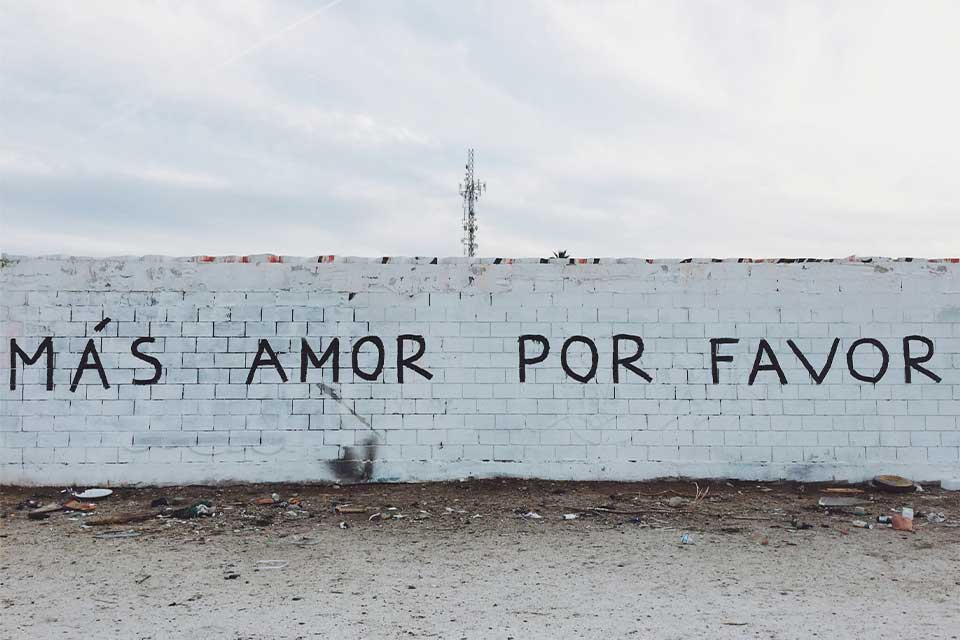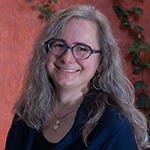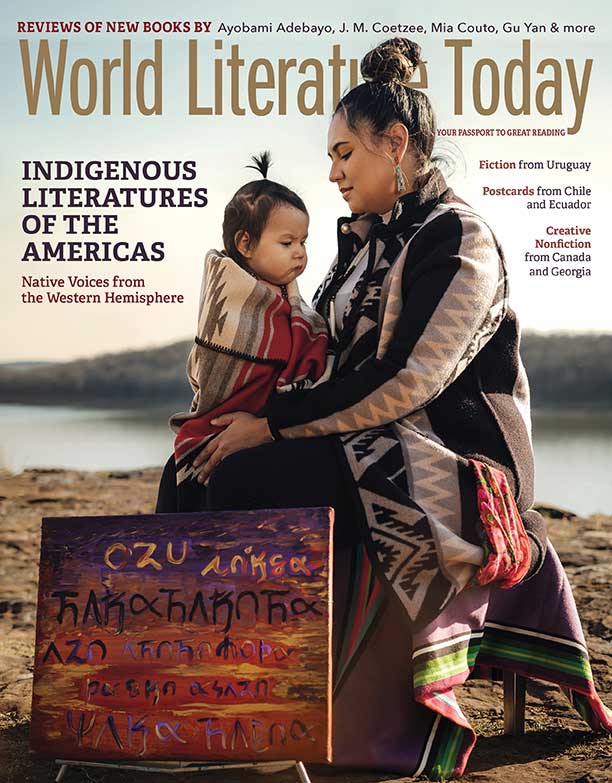Awakening Linguistic Memory: Bilingual Poetry in Mexico and Guatemala

To accompany the poems that appear by the five Indigenous writers in this issue, Wendy Call talked with them to discuss their emancipatory linguistic activism.
Approximately 85 percent of the languages currently spoken in the world are Indigenous languages. While Indigenous and First Nations peoples comprise less than 10 percent of the world’s population, they are responsible for the large majority of our global linguistic diversity. Nearly half of the six thousand Indigenous languages currently spoken are at risk of being lost before the end of the century. Writers working in these languages play key roles in sustaining them and staving off this global destruction. Two poets from Guatemala, Negma Coy and Rosa Chávez, and three from Mexico, Cruz Alejandra Lucas Juárez, Irma Pineda, and Mikeas Sánchez, shared their multilingual creative process and their language-justice work with me in a series of conversations in Spanish—both in person and virtually—over the last year.
“We’re not just writing literature in an Indigenous language for our own community,” says Irma Pineda, a Zapotec writer and educator who has published twelve bilingual poetry collections, written both in Didxazá (Isthmus Zapotec) and Spanish. “We continue to be discriminated against and attacked. Literature can help reduce this discrimination and racism by allowing others to get to know us, to see the rich cultural heritage that we have, the richness of thought and knowledge.” She believes translating literature can work magic, bringing people’s hearts and sensibilities closer to cultures and communities that they consider distant—as well as closer to their own heritages.
Pineda was the first woman to serve as president of Escritores en Lenguas Indígenas, Mexico’s national association for Indigenous-language writers. As a legislative aide in the Mexican federal congress, she played a key role in the country’s recent language-education justice laws. “It’s important not only to write in Zapotec, but also to self-translate to Spanish, because of language displacement,” she says. “We have to reach young Zapotecs who don’t speak the language. We must make a bridge through Spanish, so that those youth might fall in love with their language, and care about recovering it.”
“We must make a bridge through Spanish, so that those youth might fall in love with their language, and care about recovering it.”—Irma Pineda
Pineda describes the process of bilingual writing: “We are creating what I call idiomatic mirrors, trying to reflect both languages. But mirrors can trick us, too. There are faithful mirrors that allow us to see ourselves better, and there are also mirrors that can distort or even transform. More than the translation of an Indigenous language into Spanish, we are building two parallel poems.” These parallel poems exist in and respond to two distinct cultural contexts and literary histories.
When Pineda began writing poetry in the 1990s, there was no complete dictionary or grammar guide for Didxazá. She borrowed Didxazá books of literature and history from her teachers and neighbors, then hunted through them to find the words from her poems, to learn how to spell them.
“To write bilingually has been a challenge for me because I am an autodidact,” says Zoque poet Mikeas Sánchez. The author of six books of bilingual Zoque-Spanish poetry, she lives in her hometown of Ajway, in Chiapas, Mexico. Sánchez is the first woman to publish a book of poetry in her language and the first Zoque author to have a book in English translation. Like all the poets I interviewed for this essay, Sánchez’s formal education was entirely in Spanish.
Sánchez notes that the cultural and religious repression Zoque people have survived for centuries has prompted other forms of translation. She describes old carvings in Ajway’s Catholic church that are very clearly Zoque deities—the priests didn’t realize it, Sánchez says with a laugh, but those Zoque artists were bringing their gods into the Catholic sanctuary. “I think a lot about the violence our peoples experienced when they had to do away with their rituals and community practices; they had to be very creative to find ways to fit them into Catholicism, into their dances.” That ingenuity has inspired her as a bilingual poet.
In each of Sánchez’s six books, published between 2006 and 2019, the Zoque orthography is slightly different. The language’s written form is still being regularized, so she must update Zoque spelling with each new publication. She feels obligated to represent her language as accurately as possible, because there are so few opportunities for Zoque speakers to see their language on the page. Her community is far more likely to encounter her poetry by hearing it, rather than reading it. Sánchez worked for many years as a bilingual radio producer, and recordings of her poems circulate widely on the internet. “In Mexico, there still isn’t literacy in Indigenous languages, and this is a problem for minoritized languages like mine,” Sánchez says. “Writing isn’t just a personal goal for me, but also a way to position a minoritized language for self-recognition.”
“Writing isn’t just a personal goal for me, but also a way to position a minoritized language for self-recognition.”—Mikeas Sánchez
Back in 2006, she submitted her first poetry manuscript to publishers in Spanish only, not imagining there would be a readership for poems published in Zoque. When her publisher expressed interest in a bilingual book, she quickly added Zoque versions of the poems. Since then, she has written her books by moving back and forth between Zoque and Spanish, navigating the cultural and linguistic gaps between them. For example, there is no Zoque word for silence, a concept that Sánchez references regularly in her work. She expresses the idea in Zoque as someone “extinguishing their voice” or as “the absence of words.”
Like Mikeas Sánchez, poet Cruz Alejandra Lucas Juárez is also the only woman to have published a book of poetry in her language: Tutunakú. Both poets have navigated a double-marginalization of their languages, because Zoque and Tutunakú are unrelated to the other Indigenous languages spoken in nearby communities. Zoque is the only Native language spoken in Chiapas that is not a Maya language, while Lucas’s Tutunakú community is in a region of Puebla, Mexico, where Nahua speakers predominate.
Everyone Lucas Juárez knows who can read and write Tutunakú found their own way to biliteracy—working with a tutor, attending community workshops, or teaching themselves. “At school, everything was in Spanish, and in the community, it was entirely Tutunakú. There is no coexistence at all,” she says.
Echoing the words of many Indigenous activists, Mexican linguist Violeta Vásquez Rojas Maldonado says that this lack of coexistence and the imposition of Spanish-only literacy is “a form of deep violence.” Lucas remembers, “I always liked to read, but all the books I encountered were in Spanish. I preferred to read short stories and narrative. I didn’t like poetry, because I had read it only in Spanish and I didn’t understand it. That poetry talked about places like Paris and Spain; it had nothing to do with my environment or my community.”
“We have certain responsibilities toward our language.”—Cruz Alejandra Lucas Juárez
When she read a book of poetry in Tutunakú for the first time, she was struck by the intimacy of the experience. “I began to reflect on the life of my language and on the importance of writing poetry in a Native language. We have certain responsibilities toward our language.” Later, she was able to read books by other poets working in Mexican languages—including Irma Pineda—and that inspired her work. “If I write in Tutunakú and self-translate to Spanish, and my work finds its way into the hands of other Tutunakú speakers, they are going to prefer reading the Spanish, because they know how to read Spanish, but not Tutunakú.” There is a poignant irony here: Lucas says, “When I am with Tutunakú speakers I would never speak Spanish, because it indicates a lack of respect.” She enjoys meeting people who speak other variants of Tutunakú, to expand her poetic vocabulary. Lucas has collaborated with a group of Tutunakú writers who have translated one another’s work into Spanish, which she says has helped to alleviate the pressures of self-translation.
Maya Kaqchikel poet and artist Negma Coy also relishes collaborative work in her artistic-activist projects. “The spirit of collectivity has always called me. I don’t want to be alone.” Her collective work, in her community of Comalapa, Chimaltenango, Guatemala, is both for creative and political goals. Advocating for Kaqchikel’s equality with Spanish is one of her responsibilities as a bilingual writer. “I am happy to carry out that task because I know that my bilingual poetry is going to reach other people, and it’s a way of saying: we are still here.”
“I know that my bilingual poetry is going to reach other people, and it’s a way of saying: we are still here.”—Negma Coy
Coy’s father wanted her to learn only Spanish, believing that would help protect her from Guatemala’s pervasive racism and violence against Maya people. She is grateful that her grandmothers ensured her fluency in Kaqchikel. Coy began writing poems, stories, and ideas in notebooks during elementary school, expressing herself in Spanish and what she calls “a Spanish-ized Kaqchikel”—trying to capture the sounds of Kaqchikel with Spanish-language phonetics and spelling. The regularization of Kaqchikel orthography is still in process, and so Coy is “still learning and unlearning” her language.
“Sometimes, I will start writing something in Spanish and then I end up with more verses in Kaqchikel. Or as I’m translating from Spanish, suddenly I’m creating new verses in Kaqchikel. I play with the words in the two versions, going back and forth modifying, changing, and moving. This is the gift that self-translation gives me,” Coy says. “I like to leave the Kaqchikel essence of a text—regardless of whether it’s a short story, or a poem, or nonfiction—in the Spanish version.”
Thirteen years ago, when Coy was thirty, Kaqchikel workshops were offered in Comalapa and she was finally able to learn formal Kaqchikel orthography and begin to study ancient Maya glyphs. That experience filled a deep need in her. “I just couldn’t believe that I was receiving all these gifts at once. The moment that I encountered the glyphs, they captured my heart and spirit.” Coy has since traveled with members of her collective to the University of San Carlos in Guatemala City to continue her study.
Only about eight hundred Kaqchikel glyphs have been identified; Coy wants to learn all of them. She includes glyphs with her poems and has published children’s books that are trilingual: in alphabetic Kaqchikel, in glyphs, and in Spanish. She also offers workshops introducing young people to glyphs. “I want our children to understand that there is another way to write, created by our ancestors, and it has a profound value. And I want all of humanity to know that we’re still trying to learn what was taken away from us.”
Like Negma Coy, Rosa Chávez is an interdisciplinary Guatemalan artist and poet from Chimaltenango, who lives in Guatemala City and works as a women’s rights lawyer. Chávez’s father is Maya K’iche’ and her mother, Maya Kaqchikel, so she grew up hearing both Maya languages. She didn’t speak or read either until adulthood, when she decided to study K’iche’. “I began writing poems using traditional forms—what our Spanish-language classes taught us poetry was. I didn’t have access to modern or contemporary literature in the K’iche’ community where I grew up. I was passionate about sonnets. I was obsessed with metrical poetry, which felt like a game. This was an important way for me to find my own rhythms. It was a self-taught practice that later was liberating to break away from.”
Of her seven books of poetry, two include poems in both Spanish and Maya K’iche’. In her first book, Casa solitaria, she collaborated with her mother to translate one poem into Maya Kaqchikel. Since then, Chávez has collaborated with translators who create K’iche’ versions of some of her poems, which she describes as a political and spiritual process as well as an artistic process. She wants her poems that come most deeply from a Maya context to have a life in K’iche’ as well. “Having my poems translated into K’iche’ awakened my linguistic memory. I can’t write my poems in Maya; my understanding of the language is through memory, through how I live with my family. I was able to reconstruct my Maya identity through the translation of my poems. It has been a process of deep remembering, of ancient remembering that goes beyond just me.”
“Having my poems translated into K’iche . . . has been a process of deep remembering, of ancient remembering that goes beyond just me.”—Rosa Chávez
As a theater and performance artist, Chávez presents her poems in both Spanish and K’iche’ as a way of reclaiming her language. Her adaptation of her poems into music and movement “is a theatrical translation of my work, through the body,” she says. It is a way for her to present her work in a collective space. Echoing the words of all the poets I interviewed for this essay, Chávez insists, “All the work we do to create space for our voices is feminist work, and it is also emancipatory work. It is an exercise in regaining power. This is what poetry does and what translation makes possible.”
Seattle, Washington











